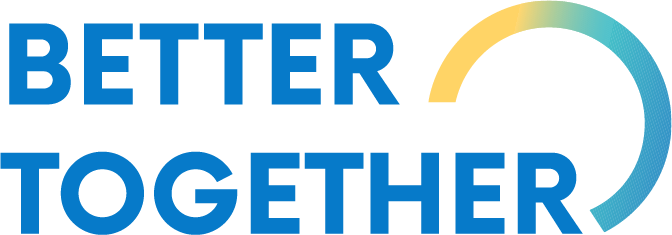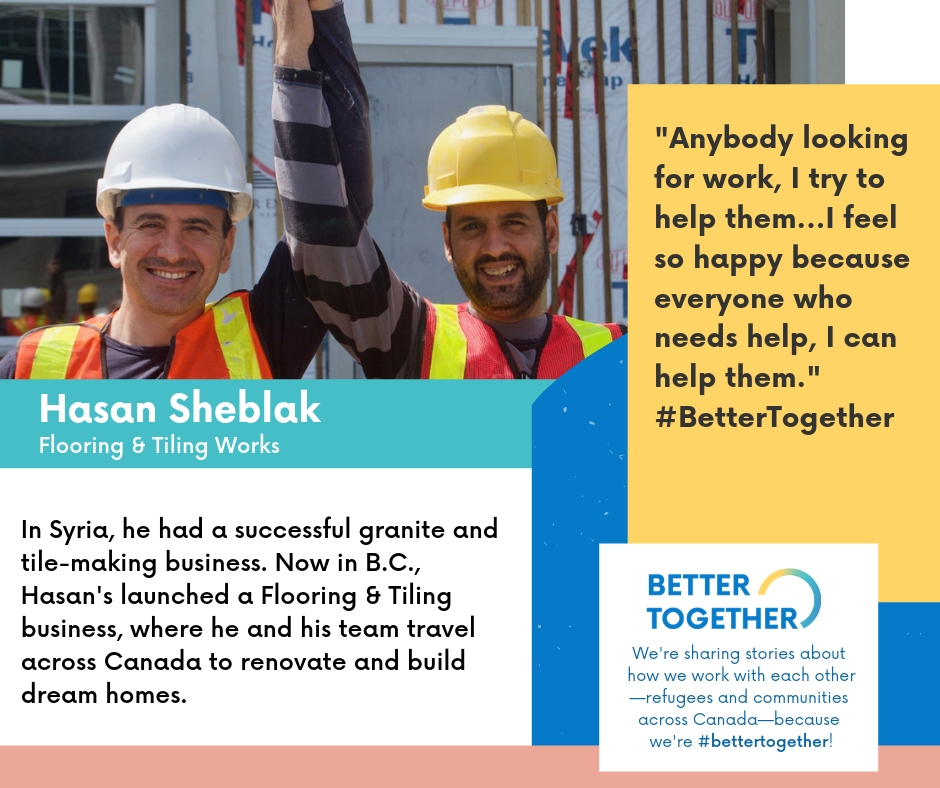 Depending on your time and capacity, there are different ways to use the Better Together Portraits. Remember, there are pre-designed canva.com portrait templates ready for you to use. Send an email for access on canva.com.
Depending on your time and capacity, there are different ways to use the Better Together Portraits. Remember, there are pre-designed canva.com portrait templates ready for you to use. Send an email for access on canva.com.
Level I: If you do not have the time to collect stories and create portraits of your own using the templates:
- Share templates, style guide and 1-page brief with other partner agencies and groups who might be interested!
- Print or download the ready-made portraits and share at community events and meetings. For a list of suggestions and other places to share, see below, “Sharing Portraits”.
- If you choose to share online, either on your website or social media, be sure to see the tips, below
Level 2: You have the time to collect stories and create portraits, or there is someone part of your group or staff who has time. Great! Follow the steps below, “Creating Portraits and Sharing Stories”:
Creating Portraits and Sharing Stories
1. Collecting stories
Start by gathering the elements you need to tell great stories. Below are a list of questions to help prompt your story collection and writing.
Important to note: as we collect stories with people who arrived as refugees and with community members, remember that not everyone wants to have their experiences or pictures shared with broader audiences. The heart of Better Together is to empower refugees by fully communicating the strengths, agency, and empowerment that they bring to new communities.
Here are a few strategies to collect stories in your community, your sponsorship group or organization. You may already have a process in place, in which case, that’s great! These are suggestions to start you off:
- Make an announcement! Let your colleagues, friends, families, church, community members know that you’re collecting stories. Be clear why you are asking them to identify stories.
- If they have never shared their stories before, if possible, meet directly with the people whose stories you are sharing.
- Before or during your meeting, explain clearly what Better Together is about, why you are collecting their story, where the portraits might be shared.
○Print out copies of the consent form or email electronically for an electronic signature.
○If the participants have agreed to share their stories and have photos taken for the portraits, remind them the day of your meeting. Alternatively, ask them to provide photos they would like to use .
●Prepare a list of open-ended questions you would like to ask them. Record direct quotes to get their perspectives! You can use the list of questions, below.
What are the steps to good storytelling? Here are some questions to ask yourself, colleagues, group members, and community members.
A note about terminology: The purpose of Better Together is to popularize stories and messages that broaden support for all who have sought refuge in Canada, no matter how they arrived. While there might be a tendency to explain the differences between statuses, PSRs, GARs, refugee claimants, refugees, asylum-seekers, the focus of Better Together, is to target messaging for the current base of supporters and ‘persuadables.’ Explaining the legal details between each category eclipse the main message, story and purpose of these materials.
- Who is the story about? Who are the main characters? Do you know them directly or is this through your group / organization / friend?
- What were the circumstance that brought them to your community? For now, remind yourself whether this person or family arrived as GAR, PSR, Refugee Claimant. If this story is about the community volunteers or private sponsors, make a note about that.
- If this is a story about people who are supporting refugees, how did that support start? What inspired it or what was the first community activity?
- What has this person / group / family brought to your community?
- If the story is about newcomer refugees or people who arrived as refugees many years ago, it can be as delightful as “Adiam provides critical nursing care in one of Calgary’s busiest hospitals, treating children in the intensive care unit.”
- If this story is about community volunteers or sponsors, describe what are they trying to contribute?
- How is your community better as a result?
- What would this person / groups neighbours, employers, teachers, etc. say about them (real life quote if possible)?
- What is the situation today?
- What can we learn from this story? What opportunities do we have to support this person’s work in the community?
- How does this story fit into one of the messages / themes for Better Together?
2. Painting the Big Picture
Once you’ve brainstormed and listed some stories and the main elements you’d like to share, if you’d like to use the portrait templates from Better Together, you’ll need to distill the stories into brief points for the poster. Here are a few questions to help get to the heart of the stories for the Better Together portraits:
- Who is in the story? Where does the story begin? For example, if someone who arrived as a refugee is sharing the story, and they are a nurse, doctor or in the medical profession now, the story could begin with the moment they were inspired to take up the profession, rather than when they arrived in Canada.
- What is the greater truth we want to tell about ourselves and our communities?
*Adapted from Welcoming America, Reframing Refugees Messaging toolkit. http://www.welcomingrefugees.org/resources/reframing-refugees-messaging-toolkit
Story Inspirations:
Hasan Sheblak, Vancouver, BC:
- The owner of a home renovations business in Syria, Hasan arrived on the west-coast of Canada, eager to rebuild a life with his family.
- He’s now launched a Flooring and Tiling business in BC, where Hasan and his team help others in his community renovate and build their dream homes.
- Hasan says,“Anybody looking for work, I try to help them...I feel so happy because everyone who needs help, I can help them.”
*Story inspiration from BC Refugee Hub
Freawet, Calgary, AB:
- With her beautiful hair and wig creations, Frewat brings smiles to cancer patients in her community and others who experience hair loss.
- Freawet, who arrived in Canada through the Refugee Assistance Program, is also the owner of a limousine and professional cleaning services business in Calgary.
- Quote: "Sponsoring refugees and supporting new lives in Canada enriches Canadian society. We bring and share talents and skills."
- For more stories like Frewat, visit
*Story inspiration from Canada Lutheran World Relief
Chefs of Tayybeh, Vancouver, BC:
- The all-female team of Chefs at Tayybeh started their full-service catering company with a sold-out pop-up dinner in Vancouver.
- Arriving from Syria just few years ago, they met one another on Canada’s west-coast while working to rebuild their families lives in their new communities.
- The Tayybeh chefs are thriving.“Success means many things: finishing university, learning the language...we’re offering this food that people love and ask for!”
*Story inspiration from BC Refugee Hub
3. Sharing the portraits
Where can you share the portraits? In:
- Newsletters (print and digital)
- Congregational bulletins / newsletters
- Submissions to relevant publications (newspaper OpEds)
- Presentations (print or digital)
Who / Where:
- Your organization, between members of your sponsorship group, with your place of worship, other community partners and agencies, public libraries, or other public displays, ie; city hall, community centres
- Who else has overlapping messages of inclusivity?
- ○Approaching local immigrant employment councils and offering them materials (TRIEC, Immigrant Employment Council of BC, and others)
- ○Local Immigration Partnerships (LIPs) and other community partners, business partners
- Do you, friends or family have employee public awareness programs at your office? Many corporate employers, such as credit unions and banks have diversity and inclusion days or offer special programs for newcomer refugees and immigrants to set-up accounts. You can offer these materials to the employees.
Online:
If you decide to share Better Together posters on social media, here are some sample tweets and tips:
●Always tag with #bettertogether. This is an easier way to gather analytics if we have a centralized hashtag
●Please tag @ccrweb and any other affiliated partners and institutions you would like to include
●Keep the message simple:
○We’re sharing stories about how we work together - newcomer refugees & people across Canada - because we’re #bettertogether!
○For more stories about how we’re thriving together -- newcomer refugees & communities across Canada - visit #bettertogether visit ccrweb.ca/stronger-communities
○We're sharing stories about how we work with each other—refugees and communities across Canada—because we're #bettertogether!
○Other ways to engage on social media:
Ask audiences if they have stories they’d like to share, either about:
- the ways refugees renew and benefit communities across Canada, be it economic, cultural or through community engagement
- the ways communities, including volunteers and sponsors, work together to welcome refugees and how they’re communities have been transformed.
